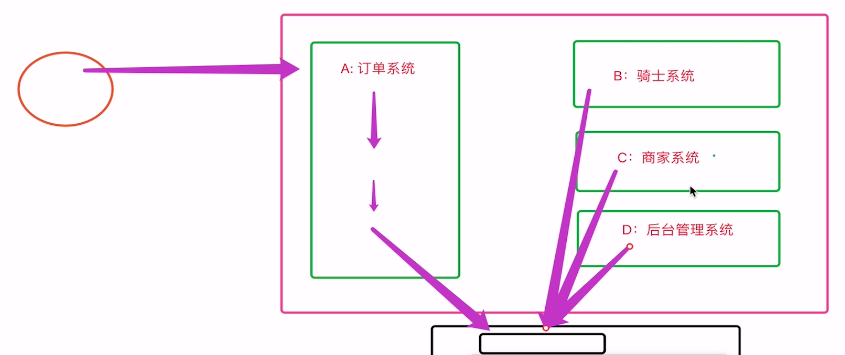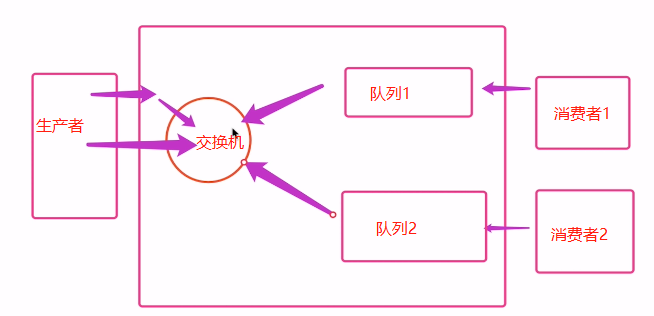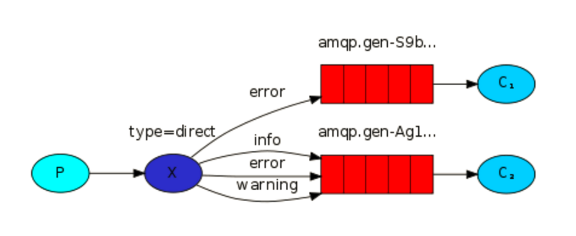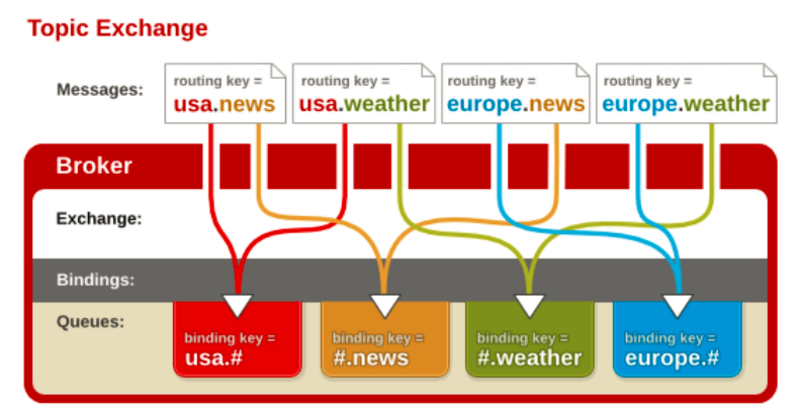消息队列RabbitMQ
https://www.cnblogs.com/pyedu/p/11866829.html
一. 什么是消息队列
MQ全称为Message Queue 消息队列(MQ)是一种应用程序对应用程序的通信方法。MQ是消费-生产者模型的一个典型的代表,一端往消息队列中不断写入消息,而另一端则可以读取队列中的消息。这样发布者和使用者都不用知道对方的存在。
1. 队列回顾
import queue q=queue.Queue(maxsize=10) # FIFO q.put(111) q.put(222) q.put(333) print(q.get()) print(q.get()) print(q.get()) print(q.get())

如果队列空了, 再取值, 则不会报错, 会阻塞住.

这种情况下, 如果队列空了再取值, 则会报错.
二. 为什么要用消息队列
消息队列中间件是分布式系统中重要的组件,主要解决应用解耦,异步消息,流量削锋等问题,实现高性能,高可用,可伸缩和最终一致性架构。目前使用较多的消息队列有ActiveMQ,RabbitMQ,ZeroMQ,Kafka,MetaMQ,RocketMQ。
接下来利用一个外卖系统的消息推送给大家解释下MQ的意义。
消息队列图:
A将信息放到队列中, 如果B, C, D监听了队列, 则可以各取一份. 如果不想取信息了, 可以解绑.

三. RabbitMQ
rabbitMQ是一款基于AMQP协议的消息中间件,它能够在应用之间提供可靠的消息传输。在易用性,扩展性,高可用性上表现优秀。使用消息中间件利于应用之间的解耦,生产者(客户端)无需知道消费者(服务端)的存在。而且两端可以使用不同的语言编写,大大提供了灵活性。
3.1 安装
windows下安装需要下载erlang, 有点麻烦.
建议在linux下安装
3.2 工作模型
rabbitmq: 一 简单模式(广泛应用) 生产者: 1 链接rabbitmq 2 创建队列 3 向指定的队列插入数据 消费者 1 链接rabbitmq 2 监听模式 3 确定回调函数 二 参数使用 1 应答参数 channel.basic_consume(queue='hello', auto_ack=False, # 默认应答改为手动应答 on_message_callback=callback) def callback(ch, method, properties, body): print(" [x] Received %r" % body) ch.basic_ack(delivery_tag=method.delivery_tag) 2 持久化参数 #声明queue channel.queue_declare(queue='hello2', durable=True) # 若声明过,则换一个名字 channel.basic_publish(exchange='', routing_key='hello2', body='Hello World!', properties=pika.BasicProperties( delivery_mode=2, # make message persistent ) ) 三 交换机模式 --- 发布订阅 --- 关键字模式 --- 通配符模式
3.2.1 简单模式
生产者 import pika
# pika是python用于连接RabbitMQ的模块, 需要pip install下载, 且在连接之前需要启动rabbitmq(启动命令: rabbitmq-server, 终止命令: rabbitmqctl) # 1 链接rabbitmq connection = pika.BlockingConnection(pika.ConnectionParameters('127.0.0.1')) channel = connection.channel() # 2 创建队列 channel.queue_declare(queue='hello') # 3 向指定队列插入数据 channel.basic_publish(exchange='', # 简单模式 routing_key='hello', # 指定队列 body='Hello Yuan!') # 数据 print(" [x] Sent 'Hello Yuan!'") 消费者 import pika connection = pika.BlockingConnection(pika.ConnectionParameters('localhost')) channel = connection.channel() # 创建队列(如果生产者已创建则不会执行, 如果没有创建则会创建队列) channel.queue_declare(queue='hello') # 确定回调函数 def callback(ch, method, properties, body): print(" [x] Received %r" % body) # 确定监听队列参数 channel.basic_consume(queue='hello', # 监听hello队列, 有数据就取出来, 没有数据就blocking auto_ack=True, # 默认应答 on_message_callback=callback) print(' [*] Waiting for messages. To exit press CTRL+C') # 正式监听 channel.start_consuming()
3.2.2 参数
3.2.2.1 应答参数
场景: 生产者将数据放到队列中后, 消费者从队列中取出数据后, 消费者端出现了错误, 导致数据丢失.
生产者 import pika # 1 链接rabbitmq connection = pika.BlockingConnection(pika.ConnectionParameters('127.0.0.1')) channel = connection.channel() # 2 创建队列 channel.queue_declare(queue='hello') # 3 向指定队列插入数据 channel.basic_publish(exchange='', # 简单模式 routing_key='hello', # 指定队列 body='Hello Yuan!') print(" [x] Sent 'Hello Yuan!'") 消费者 import pika connection = pika.BlockingConnection(pika.ConnectionParameters('localhost')) channel = connection.channel() # 创建队列 channel.queue_declare(queue='hello') # 确定回调函数 def callback(ch, method, properties, body): print(" [x] Received %r" % body) ch.basic_ack(delivery_tag=method.delivery_tag) # 拿到确认信号, 让rabbitmq删除队列中的数据. # 确定监听队列参数 channel.basic_consume(queue='hello', auto_ack=False, # 默认应答改为手动应答, 防止消费者端出错, 造成数据丢失. on_message_callback=callback) print(' [*] Waiting for messages. To exit press CTRL+C') # 正式监听 channel.start_consuming() 注意: auto_ack=False ch.basic_ack(delivery_tag=method.delivery_tag)
手动应答会降低效率, 如果追求数据安全则采用应答参数, 如果追求效率则采用自动应答.
3.2.2.2 持久化参数
场景: 生产者将数据放到队列中后, rabbitmq服务器崩掉了, 此时消费者还未获取到数据. 为防止数据丢失, 需要进行持久化存储, 就将数据存储在磁盘上.
生产者 import pika # 1 链接rabbitmq connection = pika.BlockingConnection(pika.ConnectionParameters('127.0.0.1')) channel = connection.channel() # 2 创可持久化队列 channel.queue_declare(queue='hello3',durable=True) # 3 向指定队列插入数据 channel.basic_publish(exchange='', # 简单模式 routing_key='hello3', # 指定队列 body='Hello ALEX!', properties=pika.BasicProperties( delivery_mode=2, # make message persistent ) ) print(" [x] Sent 'Hello ALEX!'") 消费者 import pika connection = pika.BlockingConnection(pika.ConnectionParameters('localhost')) channel = connection.channel() # 创建队列 channel.queue_declare(queue='hello3',durable=True) # 确定回调函数 def callback(ch, method, properties, body): print(" [x] Received %r" % body) ch.basic_ack(delivery_tag=method.delivery_tag) # 确定监听队列参数 channel.basic_consume(queue='hello3', auto_ack=False, # 默认应答改为手动应答 on_message_callback=callback) print(' [*] Waiting for messages. To exit press CTRL+C') # 正式监听 channel.start_consuming()
注意:#声明queue
channel.queue_declare(queue='hello2', durable=True) # 若声明过,则换一个名字channel.basic_publish(exchange='', routing_key='hello2', body='Hello World!', properties=pika.BasicProperties( delivery_mode=2, # make message persistent ) )
3.2.2.3 分发参数
producer.py import pika # 1 链接rabbitmq connection = pika.BlockingConnection(pika.ConnectionParameters('127.0.0.1')) channel = connection.channel() # 2 创可持久化队列 channel.queue_declare(queue='hello4') # 3 向指定队列插入数据 channel.basic_publish(exchange='', # 简单模式 routing_key='hello4', # 指定队列 body='Hello 999!', ) customer.py import pika connection = pika.BlockingConnection(pika.ConnectionParameters('localhost')) channel = connection.channel() # 创建队列 channel.queue_declare(queue='hello4') # 确定回调函数 def callback(ch, method, properties, body): import time time.sleep(5) print(" [x] Received %r" % body) ch.basic_ack(delivery_tag=method.delivery_tag) # 公平分发(谁快谁接收, 而不是轮巡) channel.basic_qos(prefetch_count=1) # 确定监听队列参数 channel.basic_consume(queue='hello4', auto_ack=False, # 默认应答改为手动应答 on_message_callback=callback) print(' [*] Waiting for messages. To exit press CTRL+C') # 正式监听 channel.start_consuming()
注意: 以上模式并不会为每个消费者各发一份, 而是按照顺序, 或者谁快就发给谁, 发完一个再发下一个, 同一份数据不会发给多个消费者.
3.2.3 交换机模式
3.2.3.1 发布订阅模式

生产者执行的步骤:
1. 连接rabbitmq
2. 创建交换机
3. 向交换机中插入数据
消费者执行的步骤:
1. 连接rabbitmq
2. 创建队列
3. 将队列绑定交换机
4. 回调函数等等
注意: 交换机接收到数据后, 会为每一个绑定的队列分发一份数据.
生产者(producer.py) import pika # 链接rabbitmq connection = pika.BlockingConnection(pika.ConnectionParameters( host='localhost')) channel = connection.channel() # 声明一个名为logs类型为fanout的交换机 channel.exchange_declare(exchange='logs', # 创建交换机 exchange_type='fanout') # fanout:发布订阅模式参数 # 向logs交换机插入数据"info: Hello World!" message = "info: Hello World!" channel.basic_publish(exchange='logs', routing_key='', body=message) print(" [x] Sent %r" % message) connection.close() 消费者(customer.py) import pika # 链接rabbitmq connection = pika.BlockingConnection(pika.ConnectionParameters(host='localhost')) channel = connection.channel() # 声明一个名为logs类型为fanout的交换机, 生产者声明了则不执行, 如果生产者没有声明则执行. channel.exchange_declare(exchange='logs', exchange_type='fanout') # 创建队列 result = channel.queue_declare("",exclusive=True) # 让系统自动起名字 queue_name = result.method.queue # 拿到队列的名字 print(queue_name) # 将指定队列绑定到交换机上 channel.queue_bind(exchange='logs', queue=queue_name) print(' [*] Waiting for logs. To exit press CTRL+C') def callback(ch, method, properties, body): print(" [x] %r" % body) channel.basic_consume(queue=queue_name, auto_ack=True, on_message_callback=callback) channel.start_consuming()
3.2.3.2 关键字模式

producer.py import pika # 链接rabbitmq connection = pika.BlockingConnection(pika.ConnectionParameters( host='localhost')) channel = connection.channel() # 声明一个名为logs类型为fanout的交换机 channel.exchange_declare(exchange='logs2', exchange_type='direct') # direct:关键字模式参数 # 向logs交换机插入数据"info: Hello World!" message = "error: Hello World!" channel.basic_publish(exchange='logs2', routing_key='error', body=message) print(" [x] Sent %r" % message) connection.close() customer.py import pika # 链接rabbitmq connection = pika.BlockingConnection(pika.ConnectionParameters(host='localhost')) channel = connection.channel() # 声明一个名为logs类型为fanout的交换机 channel.exchange_declare(exchange='logs2', exchange_type='direct') # 创建队列 result = channel.queue_declare("",exclusive=True) queue_name = result.method.queue print(queue_name) # 将指定队列绑定到交换机上 channel.queue_bind(exchange='logs2', queue=queue_name, routing_key="info" ) channel.queue_bind(exchange='logs2', queue=queue_name, routing_key="error" ) print(' [*] Waiting for logs. To exit press CTRL+C') def callback(ch, method, properties, body): print(" [x] %r" % body) channel.basic_consume(queue=queue_name, auto_ack=True, on_message_callback=callback) channel.start_consuming()
3.2.3.3 通配符
"通配符交换机"与之前的路由模式相比,它将信息的传输类型的key更加细化,以“key1.key2.keyN....”的模式来指定信息传输的key的大类型和大类型下面的小类型,让消费者可以更加精细的确认自己想要获取的信息类型。而在消费者一段,不用精确的指定具体到哪一个大类型下的小类型的key,而是可以使用类似正则表达式(但与正则表达式规则完全不同)的通配符在指定一定范围或符合某一个字符串匹配规则的key,来获取想要的信息。
“通配符交换机”(Topic Exchange)将路由键和某模式进行匹配。此时队列需要绑定在一个模式上。符号“#”匹配一个或多个词,符号“*”仅匹配一个词。因此“audit.#”能够匹配到“audit.irs.corporate”,但是“audit.*”只会匹配到“audit.irs”。(这里与我们一般的正则表达式的“*”和“#”刚好相反,这里我们需要注意一下。)
下面是一个解释通配符模式交换机工作的一个样例

producer.py import pika # 链接rabbitmq connection = pika.BlockingConnection(pika.ConnectionParameters( host='localhost')) channel = connection.channel() # 声明一个名为logs类型为fanout的交换机 channel.exchange_declare(exchange='logs3', exchange_type='topic') # fanout:发布订阅模式参数 # 向logs交换机插入数据"info: Hello World!" message = "usa.weather......." channel.basic_publish(exchange='logs3', routing_key='usa.weather', body=message) print(" [x] Sent %r" % message) connection.close() customer.py import pika # 链接rabbitmq connection = pika.BlockingConnection(pika.ConnectionParameters(host='localhost')) channel = connection.channel() # 声明一个名为logs类型为fanout的交换机 channel.exchange_declare(exchange='logs3', exchange_type='topic') # 创建队列 result = channel.queue_declare("",exclusive=True) queue_name = result.method.queue print(queue_name) # 将指定队列绑定到交换机上 channel.queue_bind(exchange='logs3', queue=queue_name, routing_key="#.weather" ) print(' [*] Waiting for logs. To exit press CTRL+C') def callback(ch, method, properties, body): print(" [x] %r" % body) channel.basic_consume(queue=queue_name, auto_ack=True, on_message_callback=callback) channel.start_consuming()





 浙公网安备 33010602011771号
浙公网安备 33010602011771号